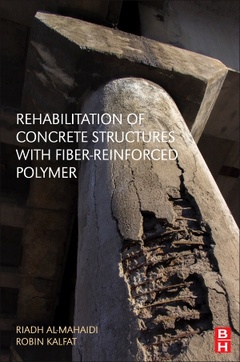Rehabilitation of Concrete Structures with Fiber-Reinforced Polymer
Auteurs : Al-Mahaidi Riadh, Kalfat Robin

Rehabilitation of Concrete Structures with Fiber Reinforced Polymer is a complete guide to the use of FRP in flexural, shear and axial strengthening of concrete structures. Through worked design examples, the authors guide readers through the details of usage, including anchorage systems, different materials and methods of repairing concrete structures using these techniques. Topics include the usage of FRP in concrete structure repair, concrete structural deterioration and rehabilitation, methods of structural rehabilitation and strengthening, a review of the design basis for FRP systems, including strengthening limits, fire endurance, and environmental considerations.
In addition, readers will find sections on the strengthening of members under flexural stress, including failure modes, design procedures, examples and anchorage detailing, and sections on shear and torsion stress, axial strengthening, the installation of FRP systems, and strengthening against extreme loads, such as earthquakes and fire, amongst other important topics.
1. Introduction 2. Methods of Structural Rehabilitation and Strengthening 3. Fiber-Reinforced Polymers and Their Use in Structural Rehabilitation 4. Design Basis for FRP Systems 5. Strengthening Members in Flexure Using FRP 6. Strengthening Members in Shear Using FRP 7. Axial Strengthening of RC Members Using FRP 8. FRP Anchorage Systems 9. Installation and Testing of FRP Systems 10. Field Applications
Researchers and practitioners in Concrete and Structural Engineering
Dr. Robin Kalfat is a Lecturer in Civil and Construction Engineering at Swinburne University of Technolgy (Melbourne, Australia). His research interests include: strengthening and rehabilitation of existing structures using advanced composite materials, protective systems to improve earthquake performance of structures and advanced numerical techniques for structural analysis.
- Presents worked design examples covering flexural, shear, and axial strengthening
- Includes complete coverage of FRP in Concrete Repair
- Explores the most recent guidelines (ACI440.2, 2017; AS5100.8, 2017 and Concrete society technical report no. 55, 2012)
Date de parution : 11-2018
Ouvrage de 413 p.
21.4x27.6 cm
Thèmes de Rehabilitation of Concrete Structures with... :
Mots-clés :
Anchorage; Axial capacity; Bidirectional fabric; Concrete or steel jacketing; Confinement; Crack injection; External posttensioning; Externally bonded; Externally bonded steel plates; Fiber-reinforced polymers; Flexural strengthening; FRP; FRP application; Laminate coupon; Lap shear; Mechanical fastening; Prestressed; Pull-off testing; Rehabilitation; Reinforced and prestressed concrete; Reinforced concrete; Reinforced concrete column; Shear capacity; Spike; Strengthening; Substrate strengthening; Surface preparation; Tensile dumbbell; Testing; U-jackets; Visual inspection; West gate bridge Melbourne; White City London



